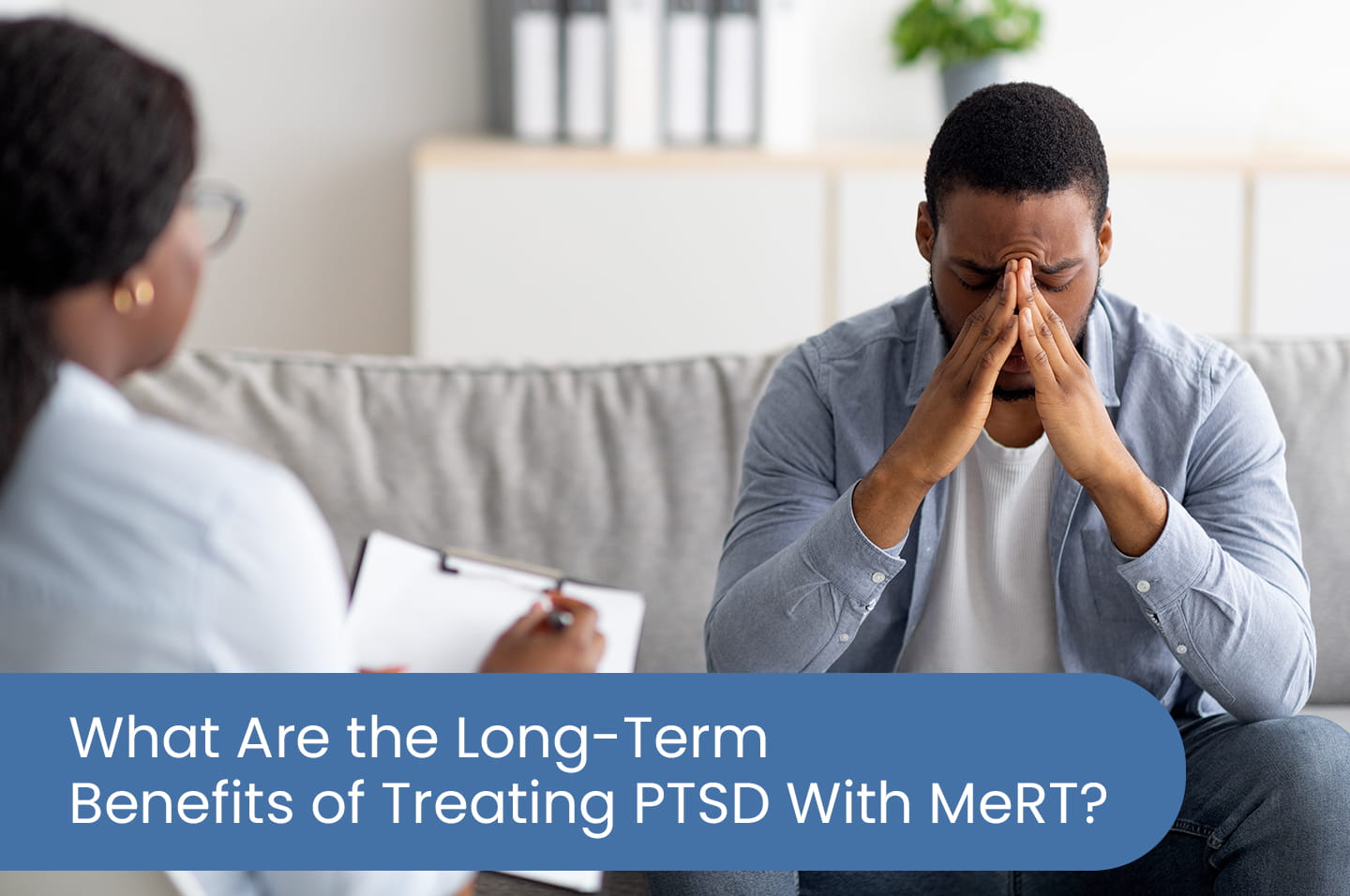
What Are the Long-Term Benefits of Treating PTSD With MeRT?
- Home /
- What Are the Long-Term Benefits of Treating PTSD With MeRT?

There are experiences that remain with us long after they end. Some arrive like earthquakes, loud and unmistakable. Others unfold more slowly, like water rising through floorboards. In both cases, trauma leaves traces. Long after the initial trauma, something lingers. A body tenses at familiar sounds. A hand clenches before the mind knows why. And suddenly, a routine interaction feels threatening.
What explains this shift? Why does the brain stay on alert when no danger is actually there? For many, this is what life with post-traumatic stress disorder (PTSD) looks like. This disorder is more than an emotional disorder. It involves a neurological change that reshapes how the mind interprets safety and danger.
Therapy, medication, and support groups—all of these approaches can help. Often, however, symptoms return. Sometimes the fear stays, and sometimes, no matter how much effort is made, something still feels off.
Luckily, new options have been developed. Among the most promising is Magnetic e-Resonance Therapy, or MeRT.
Rooted in neuroscience and tailored to each individual, MeRT represents a different kind of intervention. It doesn’t rely on pharmaceuticals, and instead offers a recalibration—one that begins with mapping the brain itself.
Understanding PTSD: A Brain and Body Response
PTSD doesn’t follow a single path. It may result from a sudden traumatic event, or from long periods of emotional strain. War veterans, survivors, first responders, and those recovering from illness or loss may all carry trauma, though the way it manifests will differ.
Symptoms of PTSD range widely, but certain patterns are common. You might feel constantly on edge, struggle to sleep, or find it difficult to connect with others. Flashbacks and panic attacks may arrive without warning. Anger can come fast, and concentration may slip away. Even in familiar places, discomfort often remains.
For some, symptoms are steady; for others, they return under stress. While many respond well to therapy or medication, others find that the effects remain.
What’s happening in the brain?
When trauma is experienced, the brain’s threat detection system, which is centred in the amygdala, becomes overactive. In a healthy state, that response fades once safety returns. For those with PTSD, the alarm continues. The brain cannot easily separate the past from the present.
A scent might trigger trauma. A light touch might feel invasive. Sleep, once a break, may start to feel unsafe. For years, treatments focused on surface symptoms. What makes MeRT different is that it begins with the brain’s circuitry.
A Groundbreaking Advancement: The Science of MeRT
MeRT combines several technologies into a customized protocol. First, a qEEG (Quantitative Electroencephalogram) is used to map the brain’s electrical activity. Then, an ECG (electrocardiogram) records heart rhythms. Together, these tests provide a detailed view of how the brain communicates, where activity is dysregulated, and how systems may be out of sync.
Using these results, clinicians apply repetitive transcranial magnetic stimulation (or rTMS) to targeted areas. However, unlike traditional rTMS, MeRT is adapted based on each individual’s unique neural signature. This is where precision becomes possible. What it offers is recalibration, not suppression of symptoms.
What does PTSD MeRT treatment look like?
Every patient’s healing journey begins with an intake appointment. You meet with a care coordinator, talk through your mental health history, and ask questions freely. From there, the testing process begins. Using non-invasive qEEG and qECG scans, your care team will gather information to help shape your personalized protocol.
During the assessment period, most patients attend weekday sessions for two weeks. At the end of the period, new tests are run to observe whether any early changes have emerged. If positive trends appear, treatment continues in blocks. Typically, 6 to 12 weeks are required, but adjustments are made case by case.
Throughout the process, progress is monitored closely. As well, because each individual has a unique brain, it’s important to remember that everyone’s path forward will look slightly different.
The Results: Changes You Can Feel
Across multiple clinical settings, patients have seen a significant drop in the severity of their PTSD symptoms, resulting in major improvements in their quality of life. For some, improvements arrive suddenly and persist. However, for others, the change is gradual, but also enduring.
People typically report longer, more restful sleep. Nightmares fade away, and focus returns. The ability to reconnect with loved ones and connect with new people becomes easier. Mood stabilizes, and emotional outbursts decline in frequency and intensity. For many, the grip of past memories loosens.
However, the memory is subdued, not erased. Triggers may still exist, but the response to them is different. Where there was once panic, there is now repose. Where there was overwhelm, there is now more space to breathe due to trauma relief.
Why MeRT, and why now?
Perhaps you’ve already tried medication. Perhaps you’ve spent years in therapy. Or, maybe you’ve done both, and still feel like you’re living from a place of survival. It’s not uncommon. Many people feel discouraged, even after doing everything they were told to do.
If healing has felt out of reach, and if traditional options have fallen short, MeRT offers something worth exploring. While it’s not a miracle cure, it is a research-driven, patient-centred therapy that has shown meaningful benefits. For those who’ve lived in fight-or-flight mode for years, that difference can be life-changing.
Who might benefit the most?
Although anyone with PTSD may be a candidate, MeRT may be especially useful for those who have not responded to medication, those who’ve experienced side effects from pharmaceuticals, and those who prefer drug-free approaches.
It may also be appealing to people who want a deeper understanding of how their brain functions and why certain patterns persist. You don’t have to settle for symptom management alone. You deserve to know what’s going on under the surface.
Looking Ahead: Long-Term Gains
Think of your nervous system like a traffic grid. For those suffering with PTSD, signals are misfired. Red lights flash when no cars are coming. Roads are closed even when the path is clear. Over time, MeRT works to rewire those pathways. It encourages communication, balance, and clarity.
As those systems recalibrate, the changes ripple outward. This leads to better emotional regulation, more restorative rest, and improved interpersonal connection. These aren’t side effects; they’re signs of healing.
Could this treatment work for everyone? There are no guarantees since healing is complex, and every person has a different story. For many, though, MeRT has opened a door that no other treatment has. That alone makes it worth considering.
Contact us for Expert PTSD MeRT Treatment
Maybe this is the first time you’re hearing about PTSD MeRT treatment, or maybe it’s the tenth. Either way, what matters most is what you do next. If something about this treatment feels right, or if you’re simply curious to learn more, you’re invited to reach out to Neurosync Brain Treatment Centre today.
We approach care with a balance of scientific precision and human compassion. Our team begins every treatment with qEEG and qECG analysis and continues to tailor each step of the process to meet your specific needs. From the first call to your last session, we are here to support your mental health improvement journey and answer your questions.
Schedule your consultation today. You can call us at 365-799-8438, email us at neurosyncbtc@outlook.com, or fill out our online form.
Working Hours
Email: neurosyncbtc@outlook.com
Woodbridge. ON. L4L 1A6

